light OLDSMOBILE SILHOUETTE 2003 Owners Manual
[x] Cancel search | Manufacturer: OLDSMOBILE, Model Year: 2003, Model line: SILHOUETTE, Model: OLDSMOBILE SILHOUETTE 2003Pages: 466, PDF Size: 21.55 MB
Page 2 of 466
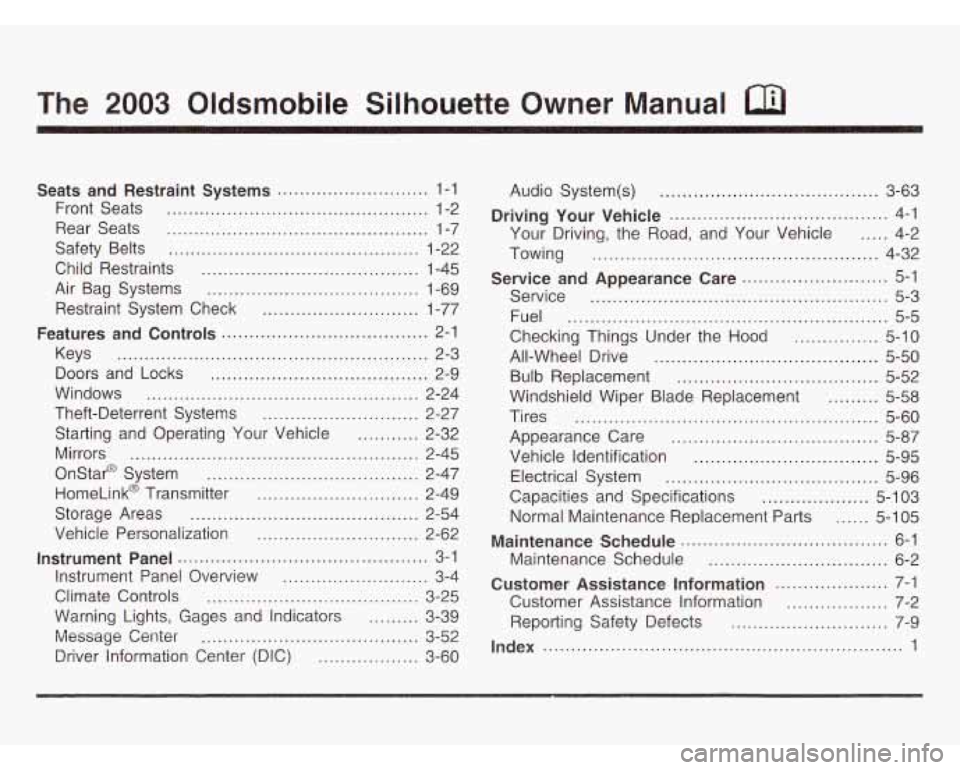
.
The 2003 Oldsmobile Silhouette Owner Manual
Seats and Restraint Systems ........................... 1-1
Front Seats
............................................... 1-2
Rear Seats
............................................... 1-7
Safety Belts
............................................. 1-22
Child Restraints
....................................... 1-45
Air Bag Systems
...................................... 1-69
Restraint System Check
............................ 1-77
Features and Controls
..................................... 2-1
Keys
........................................................ 2-3
Doors and Locks
....................................... 2-9
Windows
................................................. 2-24
Theft-Deterrent Systems
............................ 2-27
Starting and Operating Your Vehicle
........... 2-32
Mirrors
.................................................... 2-45
Onstar@ System
...................................... 2-47
HomeLink@ Transmitter
......................... 2-49
Storage Areas
......................................... 2-54
Vehicle Personalization
............................. 2-62
Instrument Panel Overview
.......................... 3-4
Climate Controls
...................................... 3-25
Warning Lights, Gages and Indicators
......... 3-39
Driver Information Center (DIC)
.................. 3-60
Instrument Panel
............................................. 3-1
Messaye Center 5-3L n r~ .......................................
Audio
System(s) ....................................... 3-63
Your Driving, the Road, and Your Vehicle
..... 4-2
Towing
................................................... 4-32
Service
..................................................... 5-3
Fuel
......................................................... 5-5
Checking Things Under the Hood
............... 5-10
All-Wheel Drive
........................................ 5-50
Bulb Replacement
.................................... 5-52
Windshield Wiper Blade Replacement
......... 5-58
Tires
...................................................... 5-60
Appearance Care
..................................... 5-87
Vehicle Identification
................................. 5-95
Electrical System
...................................... 5-96
Capacities and Specifications
................... 5-1 03
Normal Maintenance Replacement Parts
...... 5-1 05
Maintenance Schedule
................................ 6-2
Customer Assistance Information
.................... 7-1
Customer Assistance Information
.................. 7-2
Reporting Safety Defects
............................ 7-9
Driving Your Vehicle
....................................... 4-1
Service and Appearance Care
.......................... 5-1
Maintenance Schedule
..................................... 6-1
Index
................................................................ 1
Page 5 of 466

Vehicle Damage Warnings
Also, in this book you will find these notices:
Notice: These mean there is something that could
damage your vehicle.
A notice will tell you about something that can damage
your vehicle. Many times, this damage would not be
covered by your warranty, and it could be costly.
But the notice will tell you what to do to help avoid
the damage.
When you read other manuals, you might see CAUTION
and NOTICE warnings in different colors or in different
words.
You’ll also see warning labels on your vehicle. They use
the same words, CAUTION or NOTICE.
Vehicle Symbols
Your vehicle has components and labels that use
symbols instead
of text. Symbols, used on your vehicle,
are shown along with the text describing the operation
or information relating to a specific component, control,
message, gage or indicator.
If you need help figuring out a specific name of a
component, gage or indicator reference the following
topics:
Seats and Restraint Systems in Section 1
Features and Controls in Section 2
Instrument Panel Overview in Section 3
Climate Controls in Section 3
Warning Lights, Gages and Indicators in Section 3
Audio System(s) in Section 3
Engine Compartment Overview in Section 5
iv
Page 11 of 466
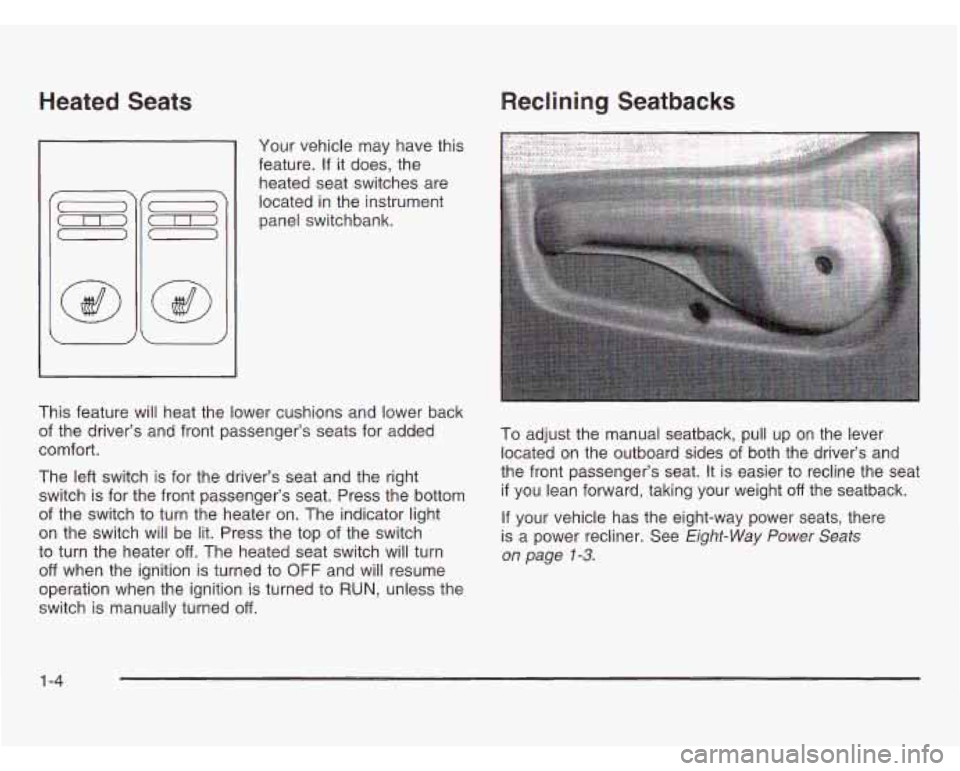
Heated Seats
Your vehicle may have this
feature. If it does, the
heated seat switches are
located
in the instrument
panel switchbank.
This feature will heat the lower cushions and lower back
of the driver’s and front passenger’s seats for added
comfort.
The left switch is for the driver’s seat and the right switch is for the front passenger’s seat. Press the bottom
of the switch
to turn the heater on. The indicator light
on the switch will be lit. Press the top of the switch
to turn the heater
off. The heated seat switch will turn
off when the ignition is turned to OFF and will resume
operation when the ignition is turned to
RUN, unless the
switch
is manually turned off.
Reclining Seatbacks
To adjust the manual seatback, pull up on the lever
located on the outboard sides of both the driver’s and
the front passenger’s seat.
It is easier to recline the seat
if you lean forward, taking your weight off the seatback.
If your vehicle has the eight-way power seats, there
is a power recliner. See
Eight-Way Power Seats
on page 1-3.
1 -4
Page 17 of 466

Removing the Split Bench Seat
Make sure the seatback is in the upright position.
1. Lift the seatback recliner lever or pull the nylon strap
on the back of the seat to fold the seatback forward.
2. From behind the bench seat, pull the nylon strap at
the center of the base of the seat to release the
rear latches from the floor pins.
Do not let go of the strap until the seat is folded all
the way forward.
3. To unlatch the front latches, squeeze the angled
bar toward the straight crossbar.
4. Remove the seat by rocking it slightly forward,
then toward the rear of the vehicle and then
pulling it out.
Repeat these steps for the other section of the split
bench seat.
1-10
Page 26 of 466

Removing the Stowable Seat
1. Remove the convenience center, if it is in the
vehicle. See
Convenience Center on page 2-60
for more information.
2. Make sure all items are off of the stowable seat.
3. If the seatback is down, put the seatback in
its upright position before removing the seat.
See “Folding the Seatback previously.
U U
5. While holding onto the crossbar at the bottom of the
seat, remove the seat by rocking it slightly toward
the rear of the vehicle and then pulling it out.
This should be done in one motion.
Notice: Do not use the release handles to pull the
seat out. The handles could break during removal.
This will not be covered by your warranty. Use
the crossbar at the bottom
of the seat when pulling
the seat out.
4. From behind the bench seat, push up the release
handles at the base of the seat to release the
iatches from the fioor pins.
1-19
Page 29 of 466
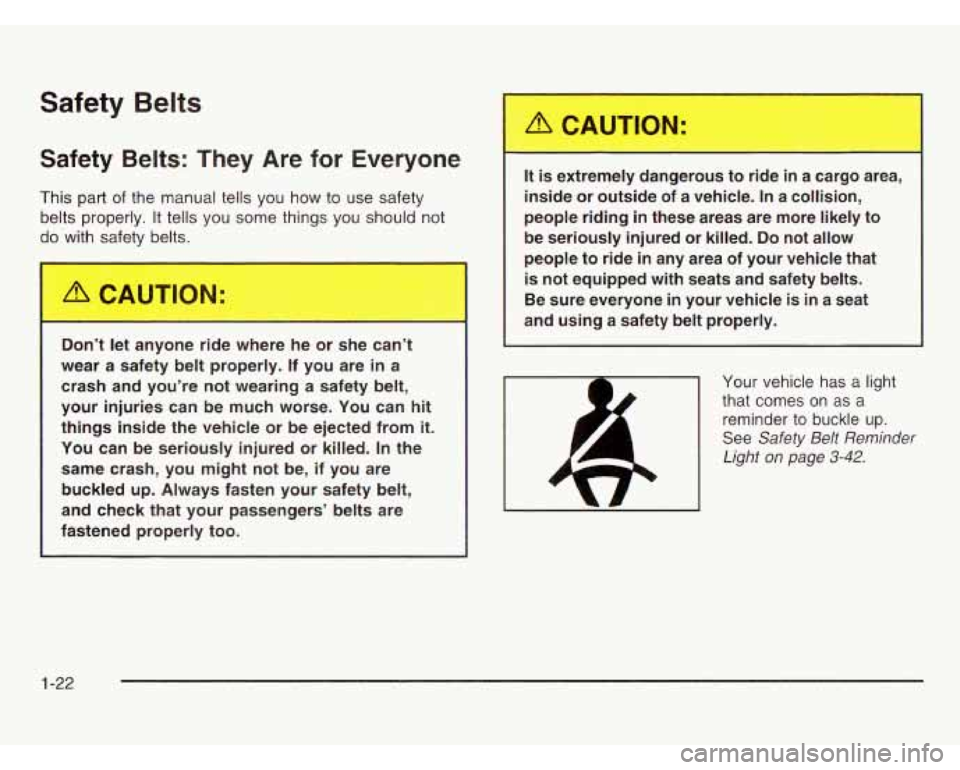
Safety Belts
Safety Belts: They Are for Everyone
This part of the manual tells you how to use safety
belts properly.
It tells you some things you should not
do with safety “-lts.
Don’t let anyone ride where he or she can’t
wear a safety belt properly. If you are
in a
crash and you’re not wearing a safety belt,
your injuries can be much worse. You can hit
things inside the vehicle or be ejected from it.
You can be seriously injured or killed. In the
same crash, you might not be, if you are
buckled up. Always fasten your safety belt,
and check that your passengers’ belts are
fastened properly too.
It is extremely dangerous to ride in a cargo area,
inside or outside of a vehicle.
In a collision,
people riding
in these areas are more likely to
be seriously injured or killed.
Do not allow
people to ride in any area of your vehicle that
is not equipped with seats and safety belts.
Be sure everyone in your vehicle is in a seat
and
using a safety belt properly.
Your vehicle has a light
that comes
on as a
reminder to buckle up.
See
Safety Belt Reminder
Light on page
3-42.
1-22
Page 35 of 466
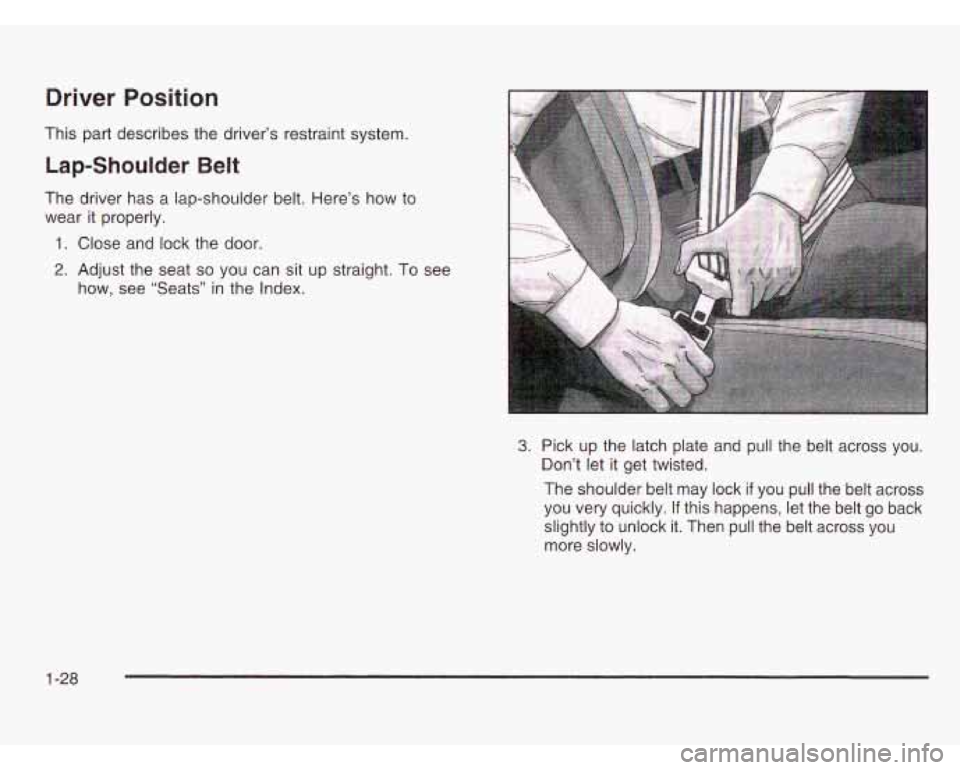
Driver Position
This part describes the driver’s restraint system.
Lap-Shoulder Belt
The driver has a lap-shoulder belt. Here’s how to
wear it properly.
1. Close and lock the door.
2. Adjust the seat so you can sit up straight. To see
how, see “Seats” in the Index.
3. Pick up the latch plate and pull the belt across you.
Don’t let it get twisted.
The shoulder belt may lock
if you pull the belt across
you very quickly.
If this happens, let the belt go back
slightly to unlock it. Then pull the belt across you
more slowly.
1-28
Page 46 of 466
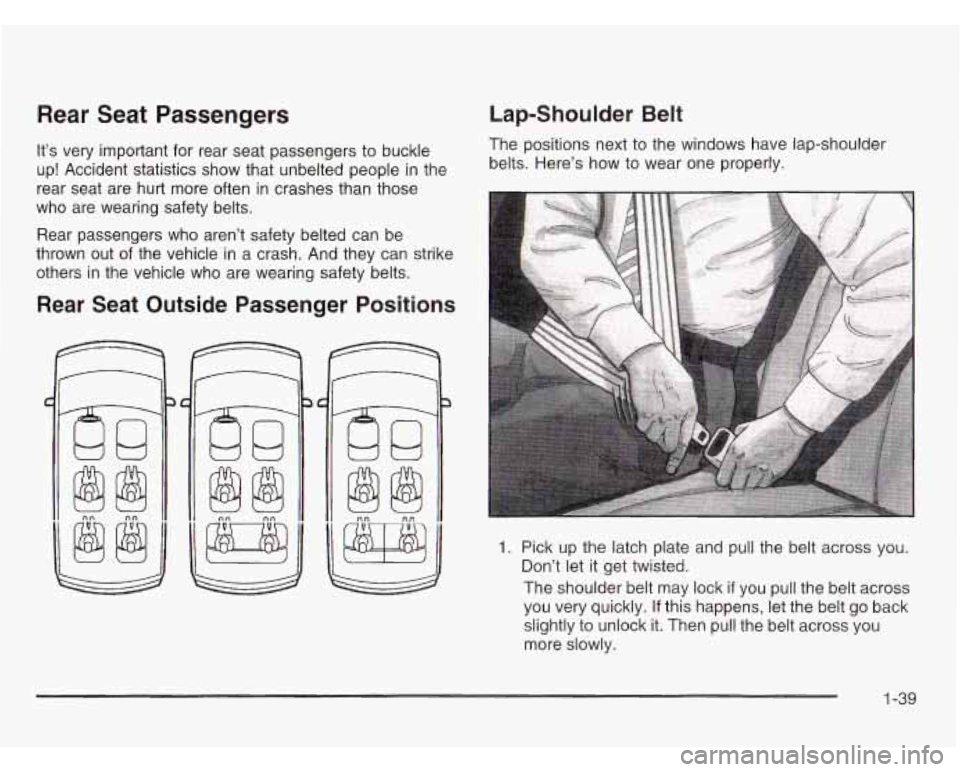
Rear Seat Passengers
It’s very important for rear seat passengers to buckle
up! Accident statistics show that unbelted people
in the
rear seat are hurt more often in crashes than those
who are wearing safety belts.
Rear passengers who aren’t safety belted can be
thrown out of the vehicle in a crash. And they can strike
others in the vehicle who are wearing safety belts.
Rear Seat Outside Passenger Positions
l@t
u
Lap-Shoulder Belt
The positions next to the windows have lap-shoulder
belts. Here’s how to wear one properly.
1. Pick up the latch plate and pull the belt across you.
Don’t let it get twisted.
The shoulder belt may lock
if you pull the belt across
you very quickly. If this happens, let the belt go back
slightly to unlock it. Then pull the belt across you
more slowly.
1-39
Page 77 of 466

A CAUTION:
~~
Both frontal and side impact air bags inflate
with great force, faster than the blink of an eye.
If you’re too close to an inflating air bag, as you
would be
if you were leaning forward, it could
seriously injure you. Safety belts help keep you
in position for air bag inflation before and
during a crash. Always wear your safety belt,
even with frontal air bags. The driver
should sit
as far back as possible while still maintaining
control of the vehicle. Front occupants should
not lean on or sleep against the door.
nm.yone who
is up against, or very close to,
any air bag when
it inflates can be seriously
injured or killed. Air bags
plus lap-shoulder
belts offer the best protection for adults,
but
CAUTION: (Continued) not for young
-..ildl-.J and infants. ..,ither
thevehicle’s safety belt system nor its air bag
system
is designed for them. Young children
and infants need the protection that a child
restraint system can provide. Always secure
children properly
in your vehicle. To read how,
see the part of this manual called “Older
Children” or “Infants and Young Children”.
There is a air bag
readiness light on the
instrument panel cluster,
which shows the air
bag symbol.
- ~~
The system checks the air bag electrical system for
malfunctions. The light tells you
if there is an electrical
problem. See
Air Bag Readiness Light on page 3-43
for more information.
1 -70
Page 84 of 466
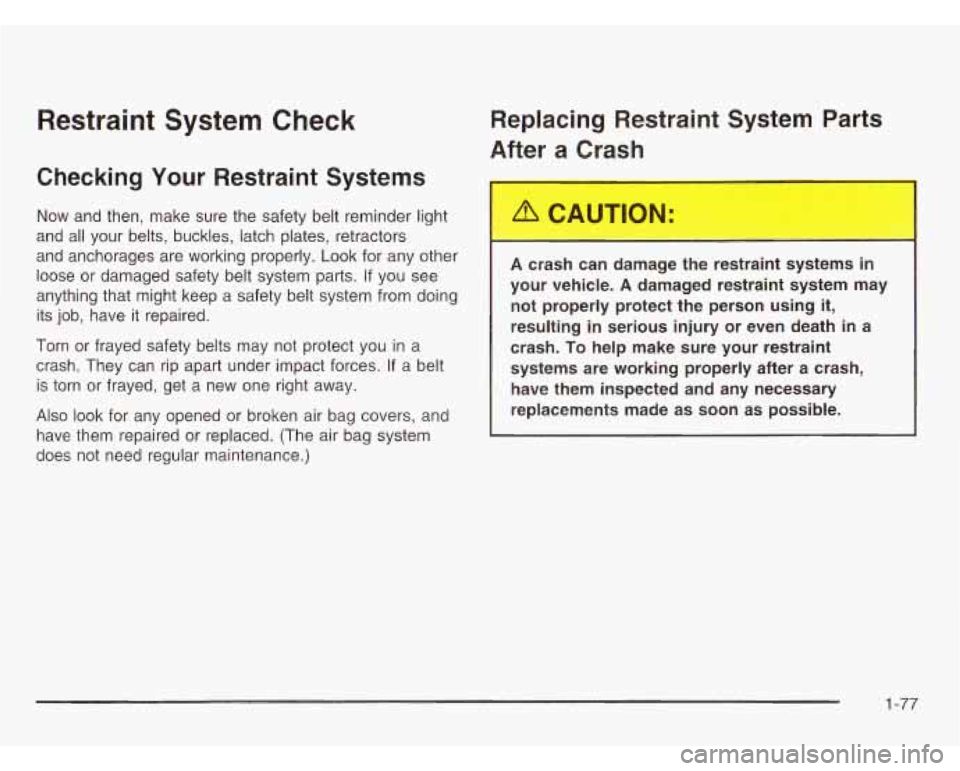
Restraint System Check
Checking Your Restraint Systems
Now and then, make sure the safety belt reminder light
and all your belts, buckles, latch plates, retractors
and anchorages are working properly. Look for any other
loose or damaged safety belt system parts. If you see
anything that might keep a safety belt system from doing
its job, have it repaired.
Torn or frayed safety belts may not protect you
in a
crash. They can rip apart under impact forces.
If a belt
is torn or frayed, get a new one right away.
Also look for any opened or broken air bag covers, and
have them repaired or replaced. (The air bag system
does not need regular maintenance.)
Replacing Restraint System Parts
Afte’
a Crash
A crash can damage the restraint systems in
your vehicle. A damaged restraint system may
not properly protect the person using
it,
resulting in serious injury or even death in a
crash.
To help make sure your restraint
systems are working properly after a crash, have them inspected and any necessary
replacements made as soon as possible.
1-77